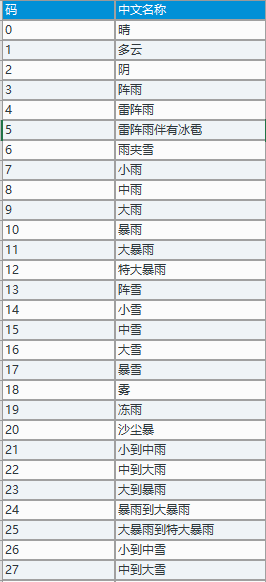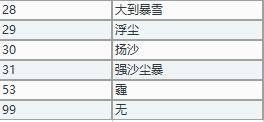android基礎學習綜合例項——天氣預報App
經過幾個月的Android學習,自己先做一個App檢驗一下學習的基礎知識怎麼樣,偶然在網上看到一些天氣Api,所以自己也想實現以下,本文主要講解在開發天氣預報App第一步——怎麼樣獲取天氣預報App?
還有很多其它的天氣預報資料介面,我只看了這3個,它們都差不多,都是根據你需要查詢的城市,再返回JSon格式的天氣預報資料。
比如中國氣象局資料開放平臺(SmartWeatherAPI):
使用規範:
請求方式: http get
介面組成: 由固定 URL 加 5 個不同的引數組成,完整 URL 需客戶
端經過固定方式加密後使用。
資料返回: json
完整 URL:
http: | 引數名稱 | 引數含義 | 引數樣例 |
|---|---|---|
| areaid | 區域 id | 單區域:101010100;多區域:101010100/101010200 |
| type | 資料型別 | 指數:index_f(基礎)、index_v(常規) 3天常規預報(24 小時):forecast_f(基礎)、forecast_v (常規) |
| date | 客戶端日期 | 按照格式 yyyyMMddHHmm 獲取客戶端當前時間 |
| appid | 固定分配的型號標識 | xx: 1234567890 傳遞引數時:擷取 appid 的前 6 位生成公鑰時:取完整的 appid |
| key | 令牌 | 由公鑰(public_key)和私鑰(private_key)通過固定演算法加密生成 |
"c":{"c1":"101010100","c2":"beijing","c3":"北京","c4":"beijing","c5":"北 京","c6":"beijing","c7":"北京","c8":"china","c9":"中 國","c10":"1","c11":"010","c12":"100000","c13":"116.391" 對用引數含義:

天氣情況表:


其它的一些內容可在氣象局提供的幫助文件中找到。
2、獲取天氣預報資料思路
根據http請求返回得到的天氣預報資料都是一些程式碼,具體含義不能直接得到,所以思路是將這些資訊新增到一個數據庫中,根據得到的天氣程式碼去查詢資料庫,最後得到具體的天氣情況。
2.1、獲得省-市-縣資訊
我們要得到天氣預報,先要知道我們先要查詢的城市的編碼,全國城市編碼都是統一的,在中國氣象資料開放平臺也可以下載到一個包含全國所有省-市-縣的編碼表(excel格式),我們需要通過程式碼將全國的城市編碼讀入到資料庫中(不是一次性讀入,是根據使用者點選的“省”)。
當開啟APP時,程式讀取excel表,先將所有的省份編碼存入到資料庫中,當用戶點選對應的省份時,先根據省份的編碼查詢資料庫,若資料庫中有該省份下的城市編碼,則直接讀取,否則就去讀取excel表,根據省份的編碼獲取對應的所有城市的編碼,以此迴圈,只有當用戶點選完所有的省份時,資料庫中才會儲存全國城市的資訊編碼。
2.2、分析編碼
例如浙江杭州蕭山的編碼101210102
前三位101是固定碼,全國所有的城市編碼前三位都是101;
第4位和第5位表示的是省份的編碼,即21表示的是浙江省;
第6、7位表示的是城市編碼,即01表示的是浙江省的杭州市;
第8、9位表示的縣(或者區)編碼,即01表示浙江省杭州市蕭山區。
當然也有特殊的省份,比如北京、上海等直轄市的編碼,因為它們下面沒有市,所以它們的編碼最後2位都是00。
2.3、獲取天氣預報資料資訊
首先根據氣象資料開放平臺分配的AppId和Private_Key,以及選擇的城市程式碼,通過加密得到http請求的加密文:
private static final char last2byte = (char) Integer.parseInt("00000011", 2);
private static final char last4byte = (char) Integer.parseInt("00001111", 2);
private static final char last6byte = (char) Integer.parseInt("00111111", 2);
private static final char lead6byte = (char) Integer.parseInt("11111100", 2);
private static final char lead4byte = (char) Integer.parseInt("11110000", 2);
private static final char lead2byte = (char) Integer.parseInt("11000000", 2);
private static final char[] encodeTable = new char[] { 'A', 'B', 'C', 'D', 'E', 'F', 'G', 'H', 'I', 'J', 'K', 'L', 'M', 'N', 'O', 'P', 'Q','R', 'S', 'T', 'U', 'V', 'W', 'X', 'Y', 'Z', 'a', 'b', 'c', 'd','e', 'f', 'g', 'h', 'i', 'j', 'k', 'l', 'm', 'n', 'o', 'p', 'q', 'r', 's', 't', 'u', 'v', 'w', 'x', 'y', 'z', '0', '1', '2', '3','4', '5', '6', '7', '8', '9', '+', '/'};
public static String standardURLEncoder(String data, String key) {
byte[] byteHMAC = null;
String urlEncoder = "";
try {
Mac mac = Mac.getInstance("HmacSHA1");
SecretKeySpec spec = new SecretKeySpec(key.getBytes(), "HmacSHA1");
mac.init(spec);
byteHMAC = mac.doFinal(data.getBytes());
if (byteHMAC != null) {
String oauth = encode(byteHMAC);
if (oauth != null) {
urlEncoder = URLEncoder.encode(oauth, "utf8");
}
}
} catch (InvalidKeyException e1) {
e1.printStackTrace();
} catch (Exception e2) {
e2.printStackTrace();
}
return urlEncoder;
}
public static String encode(byte[] from) {
StringBuffer to = new StringBuffer((int) (from.length * 1.34) + 3);
int num = 0;
char currentByte = 0;
for (int i = 0; i < from.length; i++) {
num = num % 8;
while (num < 8) {
switch (num) {
case 0:
currentByte = (char) (from[i] & lead6byte);
currentByte = (char) (currentByte >>> 2);
break;
case 2:
currentByte = (char) (from[i] & last6byte);
break;
case 4:
currentByte = (char) (from[i] & last4byte);
currentByte = (char) (currentByte << 2);
if ((i + 1) < from.length) {
currentByte |= (from[i + 1] & lead2byte) >>> 6;
}
break;
case 6:
currentByte = (char) (from[i] & last2byte);
currentByte = (char) (currentByte << 4);
if ((i + 1) < from.length) {
currentByte |= (from[i + 1] & lead4byte) >>> 4;
}
break;
}
to.append(encodeTable[currentByte]);
num += 6;
}
}
if (to.length() % 4 != 0) {
for (int i = 4 - to.length() % 4; i > 0; i--) {
to.append("=");
}
}
return to.toString();
}
public static void main(String[] args) {
try {
//需要加密的資料
String data = "http://open.weather.com.cn/data/?areaid=xxxxxxxxxx&type=xxxxxxxx&date=xxxxxxxxx&appid=xxxxxxx";
//金鑰
String key = "xxxxx_SmartWeatherAPI_xxxxxxx";
String str = standardURLEncoder(data, key);
System.out.println(str);
} catch (Exception e) {
e.printStackTrace();
}
}
}通過以上demo可以獲得加密文str,再根據上述的請求URL格式:
獲取json格式資料,再解析json資料。
/**
* 解析天氣預報資訊
*/
public static final void handleWeatherResponse(Context context,String response)
{
try
{
JSONObject jsonObject = new JSONObject(response);
JSONObject cityInfo = jsonObject.getJSONObject("c");// 城市的資訊
String cityCode = cityInfo.getString("c1");
String cityName = cityInfo.getString("c3");
JSONObject weatherInfo = jsonObject.getJSONObject("f");// 天氣資訊
// 第一天的天氣預報(當天)
JSONArray weatherInfo_f1 = weatherInfo.getJSONArray("f1");
String temp1 = weatherInfo_f1.getJSONObject(0).getString("fc");// 白天的溫度
String temp2 = weatherInfo_f1.getJSONObject(0).getString("fd");// 晚上的溫度
String weather1 = weatherInfo_f1.getJSONObject(0).getString("fa");// 白天的天氣情況
String weather2 = weatherInfo_f1.getJSONObject(0).getString("fb");// 晚上的天氣情況
// 溫度釋出時間
String publishTime = weatherInfo.getString("f0");
String Date = publishTime.substring(0, 8);// 日期
String Time = publishTime.substring(8, 12);// 時間
saveWeatherInfo(context, cityName, temp1, temp2, weather1,weather2, Date, Time);//將獲取的天氣預報資訊編碼存入到SharePreferences中
} catch (JSONException e)
{
e.printStackTrace();
}
}將獲取的天氣預報資訊編碼存入到SharePreferences中
SimpleDateFormat sdf = new SimpleDateFormat("yyyy年M月d日", Locale.CHINA);
SharedPreferences.Editor editor = PreferenceManager
.getDefaultSharedPreferences(context).edit();
editor.putBoolean("city_selected", true);
editor.putString("city_name", cityName);
editor.putString("temp1", temp1);
editor.putString("temp2", temp2);
editor.putString("weather1", weather1);
editor.putString("weather2", weather2);
editor.putString("current_date", sdf.format(new Date()));
editor.putString("time", time);
editor.commit();3、基本功能模組設計
後續新增
